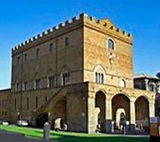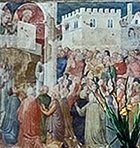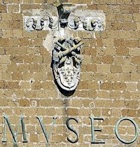


The Commune began the construction of this palace at the behest of Pope Boniface VIII after he had made peace with Orvieto. The lower part of its walls seems to be older that the rest of the palace, so it was probably built on the base of an earlier structure. Some authorities believe that this palace was built on the site of Santa Maria Prisca (the old Duomo), which was demolished in 1297, although this is not generally accepted.
The palace was still in construction when Boniface VIII died in 1303. The unfinished building was then abandoned until 1321, when the Opera del Duomo acquired it and adapted it for use by workmen who were engaged in building the Duomo.
Soliano seems to mean "south" and is applied also to the south door of the Duomo, to the street that runs along the southern edge of the city, and to the city gate at the end of it.
Structure
The palace comprised a large hall on the ground floor and another on the floor above that was lit by a series of trifore windows. A loggia in front of the east wall of the lower room supported an open terrace that was reached by a monumental external staircase. This arrangement would have allowed for ceremonial entrances into the upper room (which was probably meant to have housed meetings of the Curia) and for public proclamations to be made from the terrace.

Later History
The papacy began to take an interest in the palace in the 15th century. Pope Pius II made a payment for restoration work in 1460, and further work was carried out in 1493, when Pope Alexander VI visited Orvieto and blessed the people from its terrace. Nevertheless, it remained problematic:
-
✴The roof collapsed in 1504 when too many people climbed up on it during carnival.
-
✴There was talk of demolishing the palace in 1534 because it was unsafe and threatened the adjacent Palazzo Vescovile.
The Commune took over the palace in ca. 1540 and arranged for its partial demolition and rebuilding. Pope Paul III financed some of this work, carried out by Simone Mosca, and other payments are recorded to Meo di Giacomo Scalza. The palace passed back to the Opera del Duomo in 1550 and they commissioned further work from Ippolito Scalza in 1564-70.
The palace owes its current appearance to a major restoration carried out in 1887-98 by Paolo Zampi in what he believed to be its original form. A number of the original trifore windows in the upper room fortunately survived. Zampi rebuilt the external staircase and added the upper windows and present crenellations (which do not continue along the east wall!!).

Palazzo Soliano now houses:
-
✴the Museo Emileo Greco on the ground floor; and
-
✴number of mostly Roman objects that arranged somewhat haphazardly under its loggia.

